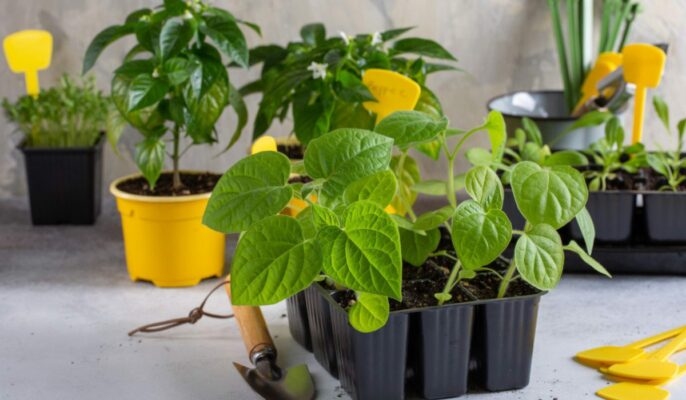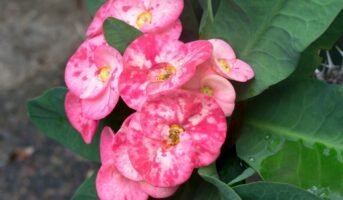Physalis peruviana, or cape gooseberry, is a vine in the family Solanaceae. Central America and South America are home to this plant. This plant is also known as uvilla, aguaymanto, or uchuva.
Its fruit has an oval shape with smooth skin and creamy white flesh inside, which contains Vitamin C (ascorbic acid). The ripe fruits taste sweet when eaten raw but become very sour when cooked or fermented into vinegar. They can replace lemon juice in desserts because of its tangy flavour.
The Physalis peruviana plant thrives in hot weather and does not need much water. It needs full sun and should be kept at an altitude of at least 500 metres above sea level. When grown indoors, it needs plenty of sunlight and can be grown in soil that is well-drained but also moist.
Physalis peruviana contains many alkaloids that have been studied for their medicinal properties. Including physostigmine (a nerve poison), physalin (a pain-relieving compound), pheromone (a sleep-inducing compound), physanalbin (an anti-inflammatory agent), and phytanic acid (an antioxidant). According to some studies, these compounds may help improve memory in older adults with Alzheimer’s disease.
Source: Pinterest
Physalis peruviana: Key facts
| Botanical Name | Physalis peruviana |
|---|---|
| Common Name | Cape Gooseberry or Goldenberry |
| Genus | Physalis |
| Clade | Tracheophytes |
| Family | Solanaceae |
| Life Cycle | Perennial |
| Mature Size | Upto 5 ft tall |
| Cultivation | Colombia, Ecuador, and Peru |
| Benefits | medicinal |
Physalis peruviana: Description
Source: Pinterest
It is a perennial plant that grows to a height of 1 to 3 feet tall, depending on the variety. The leaves are lance-shaped, ovate and with serrated edges. The flowers have five petals and are yellowish-green in colour. The fruit contains edible seeds and can be eaten fresh or dried.
What is Physalis peruviana?
Physalis peruviana is the scientific name for a flowering plant in the nightshade/ Solanaceae family. It grows and cultivated across in temperate and tropical regions of the world.
What is another name for Physalis peruviana?
It is referred to by different names such as Aguaymanto, Uvilla or Uchuva across to Colombia, Ecuador and Peru. The common names of the plant, in English, are Goldenberry, Cape gooseberry, and Peruvian groundcherry.
Physalis peruviana: Growing tips
Source: Pinterest
Physalis peruviana plants are easy to grow indoors in containers or as an annual. If you choose to grow it outdoors, it may need some protection from frost-free days (or nights). They can also be grown in gardens where they will bloom all year long.
Physalis peruviana is a great plant to grow indoors or outdoors. It’s a plant that grows to around 4 feet tall, making it a great choice for smaller spaces or growing in containers.
Physalis peruviana prefers full sun and well-drained soil. If you live in a region with very hot summers, you may want to consider planting Physalis peruviana in a container rather than directly in the ground.
Physalis peruviana does not need much fertiliser or water. It needs just enough to keep the soil moist at all times. When you start to see fruit beginning on your plant’s branches, you’ll know that it’s time to harvest.
see also about: Layering
Propagation From Seeds/Cuttings
- Physalis peruviana is easy to grow, but it does require some attention. Seeds are the first thing you need if you want to grow the plant.
- You can buy them in stores or even get them from the fruit itself. You can do this by breaking open the fruit and removing the seeds with tweezers or a toothpick.
- Alternatively, if you use cuttings instead of seeds, you save valuable time. As a result, you don’t have to wait for the seeds to sprout.
- Cuttings will work, but you must already have an old plant that has shoots from last year. These shoots ought to be about 10 cm long and ideally picked from the leaf axil. In the autumn, make a diagonal cut as long as you can from the shrub’s shoots.
- As soon as you have cleaned and dried the seeds, you should start growing your plants as soon as possible, ideally in February.
- When sowing seeds, use small nursery pots filled with normal potting soil. It is okay if some seeds remain uncovered by soil after this process! As soon as your plants can stand on their own, keep them moist, but not too wet. When your plants are ready to be moved outside, using a spray bottle to water them is the most efficient method.
- Afterwards, place the pots somewhere that is not too bright and at room temperature, such as in an east-facing window (but not too hot!). It’s now just a matter of waiting for the seedlings to emerge.
Physalis peruviana: Maintenance tips
- The care they require is fairly low, so they are a wise choice for your garden.
- You should ensure that your Physalis plant is watered each week, depending on the weather conditions and other factors.
- An organic liquid feed is also recommended when your Physalis peruviana is flowering and fruiting.
- After placing your cape gooseberries in their final growing position, they should be ready to harvest between 60 and 70 days later.
Physalis peruviana: Uses
Source: Pinterest
- Physalis peruviana is a beautiful plant with big, colourful fruit that is great for snacking and making jam.
- It is also used in healing salves and lotions and can be used as an ornamental plant.
- The leaves are used to make teas and tinctures, and the root contains a powerful alkaloid called physalin, which has been used by native peoples for centuries to treat pain, fever, and other ailments.
- The Physalis peruviana has been used for centuries as a herbal medicine in Central America and South America.
- Given the non-toxicity of this plant, the seeds can be ground up into a powder and mixed with water to form pills that are taken orally to treat stomach problems such as diarrhoea or dysentery.
- The seeds of this plant are edible when cooked or dried; they can be ground into flour or made into jams or jellies.
Physalis peruviana: Pests
In South Africa, the plants are commonly attacked cutworms in the seedbeds, red spiders in the field, and potato tuber moths near potato fields. Moreover, hares may damage the young plants, and birds may eat the fruits. Insects, including mites, whiteflies and flea beetles may also cause problems for the plant. Other common problems you may deal with when growing the plant include powdery mildew, soft brown scale, root rot and viruses. In New Zealand, plants is known to be infected by Candidatus Liberibacter solanacearum.
FAQs
Can you eat Physalis peruviana?
Yes. Raw or cooked fruit is used in pies, cakes, jellies, compotes, jams, and other edible products.
What are the benefits of Physalis fruit?
There is some evidence that they boost the immune system and reduce inflammation
Does Physalis peruviana have any poisonous properties?
There are no reported toxic effects associated with Physalis peruviana.
What is the most optimal way to consume Physalis fruit?
Raw or dried physalis can be eaten. It is necessary to remove the fruit from its casing before eating it.
Housing News Desk is the news desk of leading online real estate portal, Housing.com. Housing News Desk focuses on a variety of topics such as real estate laws, taxes, current news, property trends, home loans, rentals, décor, green homes, home improvement, etc. The main objective of the news desk, is to cover the real estate sector from the perspective of providing information that is useful to the end-user.
Facebook: https://www.facebook.com/housing.com/
Twitter: https://twitter.com/Housing
Email: editor@housing.com

